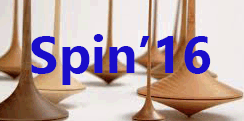Speaker
Description
The observation of an electric dipole moment (EDM) or its upper limit at levels near
10‒29 e cm would either uncover new forms of CP violation or put at risk many models that seek
to explain the excess of matter over anti-matter in the present universe. This talk presents new
results on studies of the feasibility of conducting an EDM search using a polarized deuteron beam
circulating in a storage ring. In the EDM experiment, the selection of an appropriate match of
electric and magnetic bending fields makes possible holding the direction of the polarization
always parallel to the momentum. In this configuration, the transverse electric field always present
in a storage ring will rotate the polarization into the vertical direction at a rate proportional to any
EDM on the deuteron. For this, it is necessary to maintain the polarization for times up to a
thousand seconds to allow an opportunity for the EDM signal to become observable despite the
instability of this configuration.
A time-marking system for polarimeter events has been installed on the COSY Synchrotron
at the Forschungszentrum-Jülich in Germany. The clock time information makes possible the
unfolding of the anomalous precession (~ 120 kHz at pd = 0.97 GeV/c) so that polarimeter events
may be sorted according to the direction of the rotating polarization assuming a precise value for
the precession rate. From this analysis it is possible to measure the magnitude of the in-plane
polarization (IPP) as a function of time and determine the rate at which the polarization decoheres.
This tool allows the study of ways to lengthen the IPP lifetime even though the polarization
direction is not locked to the momentum. A combination of beam bunching, electron cooling, and
the adjustment of ring sextupole fields permits the cancellation of decoherence that arises from
transverse betatron oscillations in the beam.
This talk will present the most recent results taking advantage of sextupole magnet settings
that also give zero chromaticity. From runs made in 2015, it has now been demonstrated that IPP
lifetimes can exceed 1000 seconds.
The data acquisition and analysis system also yields the phase (or direction at a particular
time) of the rotating IPP. Drifts in the COSY storage ring are slow enough that the phase may be
tracked smoothly over many 1-second time bins. This capability now makes it possible to consider
using the phase information in a slow feedback stream to the ring rf cavity so that the direction
may be made to point in a particular place and held over time. Such a capability is essential for the
EDM search. Results will be shown illustrating the operation and calibration of this feedback
system. With the use of the rf solenoid in the ring, a mock EDM-type experiment was run in which
the solenoid was used to drive a vertical accumulation of the polarization.
